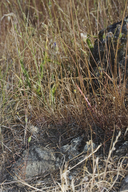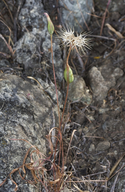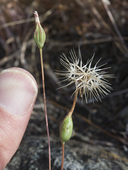notes [To fully enlarge the images in this set, click the small 'full size' link above the thumbnail on each page, then click the image again after it loads.]
-------------- Context --------------
This post concerns the stem gall of the cynipid wasp Antistrophus microseris. The gall can be seen in the lower-left portion of the full-size image...it's visible as a green, globular, bulge high on the flowering stem of a small Microseris douglasii plant (just below the fruiting head there, with its conspicuous star-like pappus scales). This goals of this post are to:
1) illustrate this interesting gall find, and pose some questions; 2) provide info on the host plant, a ''gall search image'', and suggestions to help locate these galls for field observation; and 3) encourage further observations & study by local naturalists, in the hope they'll learn and share more info about the behavior & life history of the gall inducer (and others associated with the gall, e.g. parasitoids, inquilines, etc.).
-------------- Locale, Habitat, and Host Plant --------------
The habitat here is serpentine grassland, and the location is about 4 miles northwest of Stanford University, the latter being the type locality for Antistrophus microseris...originally described as Aylax microseris in McCracken & Egbert(1922). In correspondence with local naturalist Paul Heiple, he speculated that the type locality was most likely located in serpentine grassland within the Jasper Ridge Biological Preserve.
This gall wasp's host plant, Microseris douglasii, is an annual that grows in numerous scattered patches (ranging from tens to thousands of plants) within serpentine grassland habitats in the area. The plants vary quite a bit in size (from 5–60 cm) and are scapose...meaning they have long, erect, leafless flowering stems, or 'scapes'. Those scapes arise from a tuft of long leaves at ground level. The leaves vary in shape from narrowly-linear to oblanceolate in outline, having margins that vary from entire to pinnately-lobed (image 1, image 2, image 3, image 4, image 5, image 6). Each scape bears a single flowering head which consists entirely of ray florets (image 7, image 8, image 9). The ray florets are enveloped in an involucre with a series of short outer phyllaries and another series of much longer inner phyllaries (image 10, image 11). The heads are often conspicuously pendulous, with the distal portion of the peduncle reflexed by 180° (image 12, image 13, image 14)...but the heads are also often erect. At first I assumed they were pendent in bud and erect in flower and fruit...however further scrutiny in the field suggested that they also become pendulous for a time between flowering and 'full-fruit'. By 'full-fruit' I mean the stage where the head looks like a conspicuous white 'fluff-ball' (image 15, image 16) from the aggregation of the star-like pappus-scales attached to the tips of the narrowly cylindric 'fruits' (technically cypselas) that radiate out from the base of the head. After studying plants in the field and photos online, it's not clear to what extent the disposition of the heads (i.e. fully reflexed, nodding, or erect) can be consistently linked to the stage of flowering phenology (cf. Sharsmith's comment here).
During my visit I saw no heads in actual flower, that time was already past. And most the plants appeared relatively small, with just one or two scapes. However there were also many taller & more robust plants with multiple scapes, as seen to the right in the photo here. The relative sizes and percentages of single vs. multiple scape plants present in a given year probably varies with the quality of its seasonal rainfall and temperatures.
-------------- Some Search Suggestions --------------
The first step is to find a locale where Microseris douglasii is present. Serpentine grasslands are a good place to look in the SF Bay area (though M. douglasii is not obligate to that substrate)...and using records from iNaturalist and CalFlora can help provide candidate localities. (One might also want to be on the lookout for these galls on other Microseris species...and perhaps even the closely related genera Uropappus and Stebbinsoseris, more on that in 'Questions 9-11' below.)
Once a population of Microseris is found, I'd suggest working on recognizing two useful 'mental search images' for the plants:
1) their nodding heads (image 17, image 18, image 19); and 2) their 'fluff ball'-like fruiting heads (image thumbnails).
Next, one can work on learning to distinguish the ribbon-like & aristate pappus scales of Microseris (image thumbnails) from the more common 'capillary bristle' pappus of many other genera in Asteraceae, like Hypochaeris (non-native to CA)...which also supports a related cynipid-induced stem gall — as well as many other gall-inducers!.
If you scrutinize the full-size image here, you should be able to make out numerous flowering heads of M. douglasii...perhaps better referred to as 'fruiting heads' at this late stage in their phenology. Some heads are nodding and closed; some erect and closed; one is erect with a dwindling 'fluff ball'...and many are just withered receptacles with their seeds already dropped & blown away.
Finally, if one is attempting to find Antistrophus microseris galls in a patch of Microseris plants, I suggest first developing search image familiarity with the various states of the flowering/fruiting heads...and then scanning downward along their supporting scapes for the presence of the bulging, fresh, green galls...which I'm guessing may turn reddish as the plants begin to senesce, and later tawny-brown or gray as the galls desiccate & wither.
Plant galls can go unnoticed in a given area, even when they may be somewhat abundant. Sometimes this can be due in part to people's lack of familiarity or attentiveness in what to look for. But galls are also often well-camouflaged & cryptic! In the case of Antistrophus microseris galls, there currently appear to be very few records and no substantial literature beyond the original description. I have found singletons twice, but was unable to find more nearby after an hour or so of subsequent searching. And there are observant naturalists who've spent years of field time in the area surrounding the type locality without ever noticing them. So this species may indeed be quite rare. At any rate, since I only found one here, I did not consider pursuing a collection to rear adults...out of concern for possible adverse impacts on the population.
-------------- Some Questions --------------
Most cynipids use longer-lived host plants (like oaks, and woody or at least perennial members of Rosaceae, Asterceae, etc.), whereas this species uses a comparatively ephemeral annual. This year has been very dry, and the host plants seem to be senescing fairly rapidly...which gives rise to various questions: 1) Where do these cynipids shelter in summer, fall, and early winter? (That is, after their annual Microseris host plants have died and withered and are no longer present to support them?)
2) Do they diapause in the withering gall, in the thatch-covered soil, or elsewhere? (I'm guessing they remain in the gall...even after the flowering scape withers and falls to the ground.)
3) Do they diapause between generations as larvae, pupae, or adults? (I'm guessing as pupae, as the larvae and adults may be less protected & resilient.)
4) How many (if any) other cynipid galls use such strikingly ephemeral annual plants as hosts? (This would seem to make more strigent demands on timing of emergence of short-lived adults for mating and oviposition onto a seedling host, and on the amount of time available for gall & larval growth before their short-lived Microseris hosts senesce and wither.)
5) Are they a parthenogenetic species? (The only mention of sexes I know of in the literature is the citation of the 21 females reared for the original description in McCracken & Egbert(1922). Males, if they exist, are so far undescribed.)
6) Do they have an alternation of generations (e.g. asexual & sexual), and perhaps an alternate host?
7) When do the adults emerge? (Assuming there's a single generation, my hypothesis would be after a new crop of Microseris has begun growing in earnest the following year...making fresh oviposition substrate available.)
8) Can they diapause for longer than a single season?
9) What is the relationship between Antistrophus microseris and the gall seen on Uropappus here? (The monotypic genus Uropappus is very closely related to Microseris...and those basal stem galls I found on them in 2013 appear to be an undescribed species.)
10) Can Antistrophus microseris also induce basal stem galls? Might it also be the gall-inducer on the Uropappus above?
11) Might similar galls appear on the closely related genus Stebbinsoseris? (The latter genus has two CA species thought to have arisen via allopolyploid hybridization between Microseris and Uropappus.)
12) What is the geographical range of Antistrophus microseris? (Currently, I know of only 2 records for these galls from the literature: the 1916 collection from the type locality of Palo Alto in McCracken & Egbert(1922); and a 1970 collection from the Pope Valley area of Napa County, mentioned on pg. 163 of Bugbee(1982) in connection with a chalcid wasp that emerged from the gall and was newly described in that paper. There is also a photo of what appears to be the same gall on Microseris acuminata from Bear Valley in Colusa County taken on 4/14/20. Clearly, additional observations can help establish a better sense of the geographical and host plant ranges.)
Antristrophus microseris is an interesting and currently little-known species prompting many questions! The more naturalists out there that are aware and on the lookout for it, the better chance we have to make more observations and answer some of those questions.
For more info, see the remarks & comments under: 1) my previous iNat observation from Edgewood Preserve, two miles to the northwest...and 2) the basal stem galls here. [Note: I'm posting these photos here on CalPhotos to accommodate extra large-sized images (since both BugGuide and iNaturalist have smaller image file size limits than CalPhotos. Also, text-formatting for 'blog-like' commentary (like color fonts & custom indentation) is more limited on iNat, at least to my current knowledge.]



